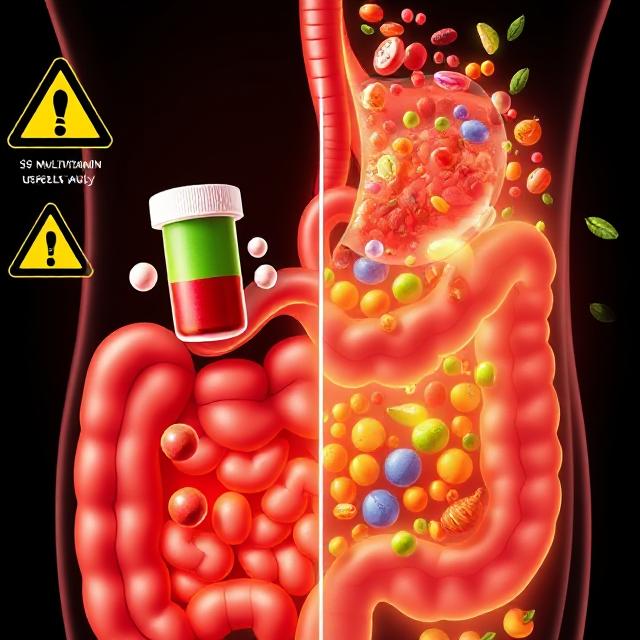
Table of Contents
Multivitamins: With Food or Empty Stomach? What Works Best
You bought a multivitamin, maybe a premium one. But now comes the question: should you take it with food—or on an empty stomach for “faster” absorption?
The answer isn’t just about comfort. It’s about absorption, bioavailability, and whether your body is even benefiting from what you’re taking. In this post, we’ll break down how multivitamins behave depending on whether you eat before taking them or not—so you can maximize benefits while avoiding side effects.
🍽️ The Digestive Basics: Why Timing Matters
Vitamins and minerals don’t float through your body passively. They interact with stomach acid, digestive enzymes, bile, and other nutrients in complex ways.
When you take a multivitamin with food, you activate:
- Bile flow → needed for fat-soluble vitamins (A, D, E, K)
- Enzymatic digestion → helps process and absorb minerals and B-vitamins
- Nutrient synergy → some vitamins need others (e.g., Vitamin D helps calcium absorption)
Taking it without food skips or weakens these mechanisms—sometimes to your detriment.
🔬 Fat-Soluble vs. Water-Soluble Vitamins
Let’s break down your typical multivitamin.
| Vitamin Type | Solubility | Best Taken With |
|---|---|---|
| A, D, E, K | Fat-soluble | With fat-containing meals |
| B-complex, C | Water-soluble | With or without food—but with food is gentler |
- Fat-soluble vitamins require bile and dietary fat to be absorbed.
- Water-soluble vitamins can be absorbed without fat—but some (like B6 and B3) can cause nausea on an empty stomach.
Verdict: Taking a multivitamin without food = poor fat-soluble uptake + increased side effects risk.
🤢 Common Side Effects on an Empty Stomach
Multivitamins taken on an empty stomach often trigger:
- Nausea or vomiting (especially B vitamins, zinc, or iron)
- Cramping or bloating
- Lightheadedness or headaches
- Diarrhea (especially magnesium oxide or vitamin C in high doses)
This occurs because certain compounds stimulate gastric acid or irritate the stomach lining when no buffer (i.e., food) is present.
⚠️ If your multivitamin causes discomfort—try switching to food-based multis and take them with meals.
🧪 Bioavailability: Getting What You Pay For
Multivitamins promise everything from better focus to immunity boosts—but only if the nutrients are actually absorbed. Taking them without food reduces that chance, especially for these nutrients:
- Vitamin D3: Needs fat and bile for proper uptake
- Iron: Better absorbed with Vitamin C, but may irritate empty stomachs
- Magnesium & Calcium: Absorbed in small amounts per dose; high doses irritate the gut
- Zinc: Needs a buffering agent (like protein) to prevent nausea
Even if you’re using a premium formula, taking it without food may waste 30–60% of the fat-soluble content.
🧠 Optimize absorption: take your multi with a meal that includes healthy fats—think eggs, avocado, olive oil, nuts, or salmon.
⏰ When Should You Take Your Multivitamin?
✅ Best Time:
- With lunch or dinner—meals tend to be more complete and include dietary fat
- With your largest meal—enhances absorption, stabilizes blood sugar
🚫 Worst Time:
- First thing in the morning on an empty stomach—you’re risking stomach upset and poor fat-soluble uptake
If your goal is energy support: consider a split-dose formula—B-complex in the morning (with food), minerals at night.
📊 Quick Chart: What to Pair & What to Avoid
| Nutrient | Needs Food? | What Helps | What Hurts |
|---|---|---|---|
| Vitamin A, D, E, K | ✅ Yes | Healthy fats | No fat or coffee |
| B-complex | ⚠️ Yes (ideally) | Protein, carbs | Empty stomach |
| Iron | ✅ Yes | Vitamin C, meat | Coffee, dairy |
| Magnesium, Calcium | ✅ Yes | Balanced meals | High fiber, caffeine |
| Zinc | ✅ Yes | Protein | Empty stomach |
🚫 Misconceptions to Avoid
Myth: “Taking a multivitamin on an empty stomach boosts absorption.”
Reality: That only applies to certain water-soluble vitamins—and even then, the side effects often outweigh the benefit.
Myth: “If I feel nauseous, that means it’s working.”
Reality: Nausea is a sign of irritation, not efficacy. It suggests poor absorption or wrong timing.
Myth: “I can just take it with black coffee.”
Reality: Coffee may reduce iron, calcium, and B-vitamin absorption due to polyphenols and acidity.
🧭 Personalized Adjustments
If you:
- Get nauseous even with food: Switch to whole-food based multis or split doses across meals.
- Follow fasting protocols: Schedule multis with your first post-fast meal, ideally including fat.
- Take medication: Check interactions—some vitamins impair drug uptake (e.g., calcium + thyroid meds).
- Train or recover: Add your multi to a post-workout recovery meal to time nutrients with repair windows.
🧠 Final Verdict: Food Wins
Taking multivitamins with food is a simple, powerful way to:
- Avoid stomach irritation
- Improve absorption
- Activate co-factors for metabolism
- Enhance long-term results
Don’t waste your stack—or your stomach—by ignoring timing.
Your body isn’t a pill disposal system. It’s a biofeedback loop. Listen to it.